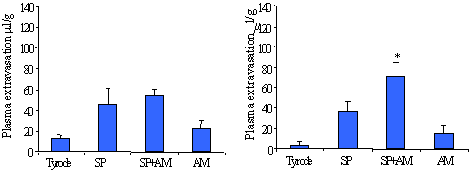| pA2 online © Copyright 2004 The British Pharmacological Society |
167P
GKT, University of London Winter Meeting December 2003 |
|
Effect of
adrenomedullin in RAMP2 overexpressing mice
|
|
CGRP and adrenomedullin (AM) are vasodilator peptides and calcitonin receptor-like receptor (CL)/receptor activity modifying protein (RAMP) 1 and CL/RAMP2 heterodimers are their corresponding receptors (McLatchie et al., 1998). Previous studies have indicated that total deletion of the AM gene is a fatal genotype (Caron & Smithies, 2001). Thus, heterozygote knockout mice or mice overexpressing the AM peptide or AM receptor protein are the approaches of choice when examining this peptide. Using mice overexpressing the RAMP2 protein (TG), a plasma extravasation assay was utilised to try to identify the presence of the CL/RAMP2 receptor in vivo, as direct measurement of blood flow in murine skin has proved difficult. Microvascular vasodilators, such as AM, do not induce plasma extravasation when injected alone, but potentiate oedema formation caused by mediators of increased microvascular permeability, such as substance P (SP), in species including the mouse (Tam & Brain, 2003). A SigMyc- mRAMP2 cDNA construct was inserted into fertilized oocytes and then introduced in to the genome of C57Bl6 mice. TG (hemizygote) or wild type (WT) mice (20-25g) were anaesthetised with urethane (2.5mg/g, i.p.) and 3.6kBq 125I-BSA injected i.v. AM (10-30pmol/site) or CGRP (0.1-1pmol/site) was injected i.d. in the presence or absence of SP (300pmol/site). After 30 min blood samples were taken by cardiac puncture, and plasma and skin sites assessed for radioactivity. Plasma extravasation was assessed as the extra-vascular accumulation of 125I-BSA.
Dose response studies revealed significant potentiation with 30pmol/site of AM in the TG mice but not in their WT counterparts (see figure 1). The responses of CGRP (1pmol/site) with SP were similar (WT 78.7 ± 16.9 and TG mice 78.6 ± 11.9µl/g). Data is shown as mean ± s.e.mean, n=9-10.

Fig.1 Effect of AM (30pmol) on SP induced plasma extravastion in WT (left) and TG (right) mice. *=p<0.05 by ANOVA and Bonferroni's t test.
These results, suggest that the overexpression of RAMP2 leads to an increased response to AM in the TG mice compared with WT. In conclusion, these findings provide preliminary evidence that these mice may be important in increasing understanding of CL/RAMP interactions in vivo.
Caron, K.M. &
Smithies, O. (2001). P.N.A.S. USA, 98, 615-619.
McLatchie, L.M. et al., (1998). Nature, 393, 333-339.
Tam, C.W. & Brain, S.D. (2003). J. Mol. Neurosci, in press.
C. Tam is supported by the British Heart Foundation.